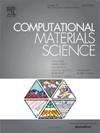IF 3.1
3区 材料科学
Q2 MATERIALS SCIENCE, MULTIDISCIPLINARY
引用次数: 0
摘要
由聚酰亚胺合成的激光诱导石墨烯(LIG)因其独特的热性能和机械性能,在自愈合应用方面具有非凡的潜力。本研究利用 ReaxFF 反应力场进行分子动力学模拟,研究了 LIG 在不同温度、压力和缺陷条件下的自修复机制。结果表明,LIG 可以自主修复结构损伤,在 300 K 和 0 atm 压力下,在拉伸诱导断裂后可恢复约 23% 的原始碳碳键。对于原始石墨烯,高温可通过克服能量障碍实现缺陷愈合,从而利用碳原子源重建晶格。与此相反,本研究表明,这种机制对 LIG 来说是不正确的,突出了一种独特的自愈合行为,并标志着本研究的一个重要结论。相反,增加压力(如 0.1 atm)会限制原子运动,从而阻碍愈合效率,导致键合恢复率降低。模拟还显示,在最佳条件下,受损 LIG 在愈合后的应力分布会变得更加均匀,从而提高材料的耐久性。这些发现强调了 LIG 自主恢复结构完整性的能力,为其在电子、纳米设备和复合材料领域应用的高性能耐用材料奠定了基础。本文章由计算机程序翻译,如有差异,请以英文原文为准。

Exceptional potential of laser-induced graphene for self-healing applications
Laser-induced graphene (LIG), synthesised from polyimide, exhibits exceptional potential for self-healing applications owing to its unique thermal and mechanical properties. This study employed molecular dynamics simulations using the ReaxFF reactive force field to investigate LIG’s self-healing mechanisms of LIG under varying temperatures, pressure, and defect conditions. The results demonstrate that LIG can autonomously repair structural damage, restoring approximately 23 % of its original carbon-carbon bonds after tensile-induced fractures at 300 K and 0 atm pressure. For pristine graphene, high temperatures enable defect healing by overcoming energy barriers, allowing lattice reconstruction with carbon atom sources. In contrast, this study shows that such a mechanism is incorrect for LIG, highlighting a distinct self-healing behavior and marking a key conclusion of this research. Conversely, increased pressures (e.g., 0.1 atm) hinder the healing efficiency by restricting atomic movement, resulting in lower bond restoration rates. Simulations also reveal that the stress distribution in damaged LIG becomes more uniform post-healing at optimal conditions, enhancing material durability. These findings underline LIG’s capability to recover structural integrity autonomously, providing a foundation for its use in high-performance, durable materials for applications in electronics, nanodevices, and composite materials.
求助全文
通过发布文献求助,成功后即可免费获取论文全文。
去求助
来源期刊

Computational Materials Science
工程技术-材料科学:综合
CiteScore
6.50
自引率
6.10%
发文量
665
审稿时长
26 days
期刊介绍:
The goal of Computational Materials Science is to report on results that provide new or unique insights into, or significantly expand our understanding of, the properties of materials or phenomena associated with their design, synthesis, processing, characterization, and utilization. To be relevant to the journal, the results should be applied or applicable to specific material systems that are discussed within the submission.
 求助内容:
求助内容: 应助结果提醒方式:
应助结果提醒方式:


